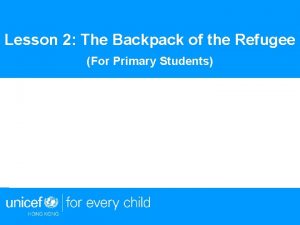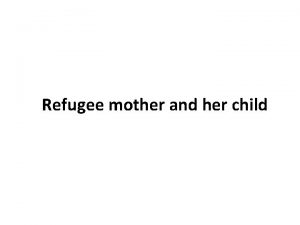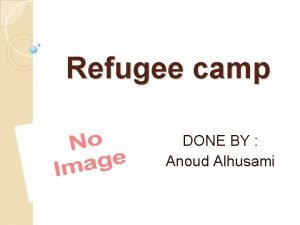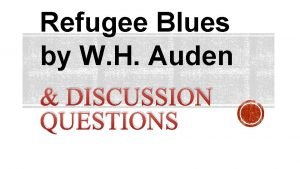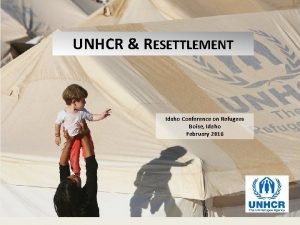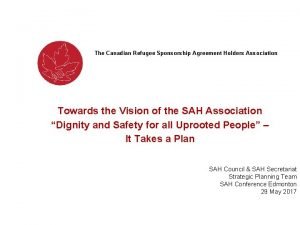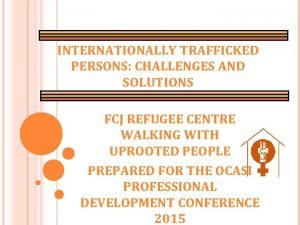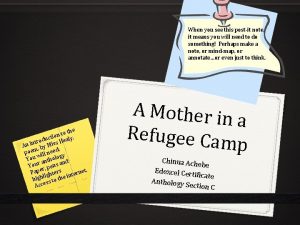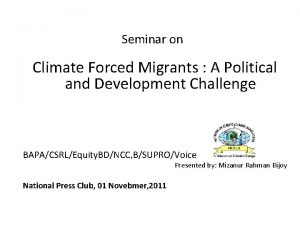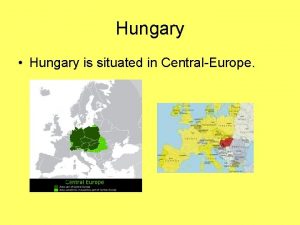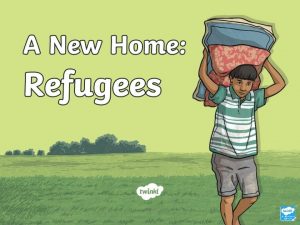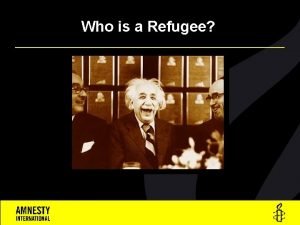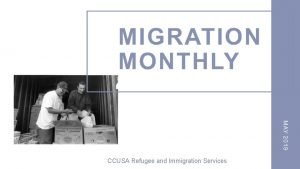The Refugee Situation Hungary Training activity Madrid April














- Slides: 14

The Refugee Situation: Hungary Training activity Madrid April 17 th-20 th 2017 A program of Fundación Senara

The refugee situation in your country 12. 000 asylum seekers residing in Hungary (half of them have been in asylum detention. Mostly Syria, Afghanistan, Iraq and Iran Located on the route refugees used to enter the UE, Hungary has expirienced a surge of xenofobia since the huge refugee flow started on 2014. The increased numbers of arrivals has spurred adoption of several restrictive measure from the Goverment including the creation of the so-called “Shengen 2. 0” which include the construction of fences in the borders with Serbia and Croation and amending the Criminal Code to punish unauthorized entry.

The refugee situation in your country How many refugees are there in your country? Countries of origin. The evolution of refugees in your country over the last few years # % Afghanistan 955 40 Syria 505 21 Iraq 385 16 Pakistan 125 5 Algeria 90 4 Other 345 14

The Refugee Crisis In the first three months of 2016, the number of asylum seekers decreased significantly as result of Hungary’s policies and the blocking of the so called Balkans route by the closure of the Greece-Macedonia border as well as the EU-Turkey deal. On 9 March, the fovernment announced the introduction fo a new state of emergency due to mass migration and aslo started to promote its own programe of militarisation, criminalisation and isolation (Schengen 2. 0). Since the beginning of July a new st of amendments to the Law on Asylum, the Law on the National Border and the Law governing the Entry and Stay of Third Country Nationals have enabled the police to apprehend and escort asylum seekers who are found within 8 km of the bprder on the other side of the fence, pushing them back to Serbian territory without any process or consideration. As to the refugees residing in Hungary, in May the National Assembly passed a set of amendments significantly cutting acces to housing, healthcare and intefration programmes, these ammendments brought an end to support programmes grantinf acces to language courses and employment counselling and aslo introduced the obligation of review the international protection statuts every three years.

The Refugee Crisis Your country policies in relation to the refugee crisis. Procedure Entry through the transit zones: Since March 2016, an ever-growing number of migrants continue to gather in the “pre-transit zones”, which areas partly on Hungarian territory that are sealed off from the actual transit zones of Röszke and Tompa, by fences in the direction of Serbia. The clear factors that determine who is allowed access to the transit zone are time of arrival and extent of vulnerability. The other determining factors are not so clear. In Röszke there are three separate lists for those waiting: one for families, one for unaccompanied minors and one for single men. In Tompa there is a single list containing the names of all three groups. Both lists are managed by a so-called community leader or list manager who is chosen by the people waiting at the given place and who communicates both with the Serbian and Hungarian authorities. Only 5 people per transit zone are allowed to enter per day. In January 2017, the HHC’s attorneys were denied access to the part of the transit zone where asylum seekers are placed. They can only provide legal assistance to those who already signed the mandate.

Irregular entry: Legal amendments that entered into force on 5 July 2016 allow the Hungarian police to automatically push back asylum seekers who are apprehended within 8 km of the Serbian-Hungarian or Croatian- Hungarian border to the external side of the border fence, without registering their data or allowing them to submit an asylum claim, in a summary procedure lacking the most basic procedural safeguards. Between 5 July and 31 December 2016, 19, 057 migrants were denied access (prevented from entering or escorted back to the border) at the Hungarian-Serbian border. Serious inhuman treatment by the personnel in uniforms was reported by various sources. Dublin: In May 2016, the IAO started to issue Dublin decisions on returns to Greece again. The IAO is of the opinion that the M. S. S. case is no longer applicable, since Greece has received substantial financial support and the reception conditions in Greece are not worse than in some other EU countries. In some cases the HHC lawyers successfully challenged such decisions at the domestic courts and in two cases the HHC obtained Rule 39 interim measures from the ECt. HR. In December 2016 the practice changed again and no more Greece Dublin transfer decisions are issued. Safe third country: In 2016 the Supreme Court’s opinion on Serbia as a safe third country was withdrawn, on the ground that legislation has since changed and its application based on current asylum and migration laws is no longer possible. The practice of the Hungarian courts regarding the inadmissibility decisions based on Serbia being a safe third country has varied. Inadmissible decisions based on safe third country ground continue to be issued in most of the cases where asylum seekers arrive through Serbia. Relocation: Hungary has not applied the relocation scheme to date, and has brought an action before the CJEU to challenge the legality of Council Decision 2015/1601.

Reception conditions Accommodation: The centre in Nagyfa was closed in August 2016, while Bicske, the closest reception to Budapest, was closed in December 2016. Balassagyarmat, Kiskunhalas, Körmend and Vámosszabadi are still operating and located in smaller towns and further away from the capital. When Bicske camp was closed in mid. December 2016, several single men were ordered to go to the tent camp of Körmend, despite the fact that there were free capacities in other open centres in the country, which were not tent camps. Despite improper heating system in tents, which caused inhuman treatment of the residents in harsh winter, the requests to be relocated to other camps were not approved by the IAO in 2016; only in mid-January 2017 was the change of camp approved. Financial allowance: Since 1 April, 2016 asylum seekers are not entitled to receive pocket money.

Detention of asylum seekers Detention centres: The newly built asylum detention centres in Kiskunhalas was opened on 11 April 2016. The new facility has gradually been filled by the end of July and it ran with almost full capacity during the summer. Asylum detention is implemented in 3 places: Kiskunhalas, Nyírbátor and Békéscsaba. In 2016 there were often periods when there were more asylum seekers detained than in open reception centres. Legality of detention: In the O. M. v. Hungary judgment of 5 October 2016, the ECt. HR found that detention was not assessed in a sufficiently individualised manner and that the authorities did not exercise particular care in order to avoid situations facing an asylum seeker on account of his sexual orientation, which risked reproducing the plight that forced him to flee. Further on, detention for the purpose of establishing the asylum seeker’s identity does not fall under the scope of Article 5(1)(b) of ECHR, when asylum seeker makes reasonable efforts to clear his/her identity, because there is no legal obligation for asylum seekers in Hungary to provide documentary evidence of their identity Content of international protection Residence permit and review: The duration of Hungarian IDs issued to refugees was reduced from 10 years to 3 years, whereas in the case of persons with subsidiary protection, it was reduced from 5 years to 3 years as of 1 June 2016. According to the same reform, refugee and subsidiary protection statuses are to be reviewed every 3 years. Integration support: As a result of legislative changes in April and June 2016, all forms of integration support were eliminated. Since the entry into effect of Decrees 113/2016 and 62/2016 and the June 2016 amendment to the Asylum Act, beneficiaries of international protection are no longer eligible to any state support such as housing support, additional assistance and others.

How many have we hosted in your country? The situation in the hungarian border, the pre-transit camps, the camps and the containers makes the entry to the country a torture as well as has forced the migration diaspora to take other routes and methods which imply more risking of their life. The Governmet has used over 18 million dollars in a campaing to spread hate speech to inmigrants and refugees. The ammendments on the law asylum system have made the integration of the asylum seekers residents very difficult. To improve this situation action agains hate speech should be taken as well as decreasing the xenophobia of the Hungarian citizens. Also integration programs, mostly related to language and work should be carried out.

How many have we hosted in your country? Future steps to provide hosting for refugees Since 2012, Germany has been the primary destination country for asylum seekers in Europe, receiving 442, 000 asylum applications in 2015 alone. Following Germany, Hungary (174, 000 applications) and Sweden (156, 000) received the highest number of asylum applications in 2015. Meanwhile, France (71, 000) and the UK (39, 000) received roughly the same number of applications in 2015 as in years just prior to the refugee surge in 2015. Hungary received the second largest number of asylum applicants in 2015. In all, Hungary received 174, 000 asylum applications or about 13% of Europe’s asylum seekers in 2015.

What are the principal organizations of your country doing? International Organization fot Migration: main projects HEADSTART: Fostering Integration Before Departure Migration for Development in the Western Balkans (MIDWEB) At Home in Hungary Independent Network of Labour Integration and Social Inclusion Experts (LINET) Migrants in the Spotlight: Training and Capacity Building for Media MIGSZOL- Migrant solidarity group of Hungary Campaining against the Goverments policies Integration procedures

What are the principal organizations of your country doing? - Campaigns - Visibility -Mapping resources - Collaborating with other minority groups - Organizing events

Add information of interest

Add information of interest Some 17, 800 people managed to enter Hungary illegally prior to the major change in legislation that came into force on July 5. Since then, just 470 people have entered the country illegally; a significant number tried to enter the country via Romania and Ukraine.
 Refugee backpack activity
Refugee backpack activity Refugee backpack activity
Refugee backpack activity Refugee blues poem summary
Refugee blues poem summary Refugee mother and child poem analysis
Refugee mother and child poem analysis Refugee camp definition
Refugee camp definition Saw a poodle in a jacket fastened with a pin meaning
Saw a poodle in a jacket fastened with a pin meaning Refugee discussion questions
Refugee discussion questions Idaho refugee conference
Idaho refugee conference Sponsorship agreement holders
Sponsorship agreement holders Circulation definition ap human geography
Circulation definition ap human geography Fcj refugee centre
Fcj refugee centre Summarise the poem “a mother in a refugee camp”
Summarise the poem “a mother in a refugee camp” 1951 refugee convention
1951 refugee convention 1951 refugee convention
1951 refugee convention Shamshatoo refugee camp
Shamshatoo refugee camp
